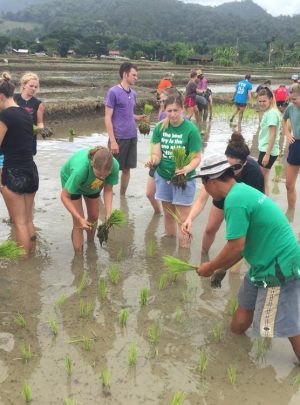Trip Types
Trip Types

Budget travel
Budget travel
Travel is the movement of individuals between relatively distant geographical locations, and may involve move foot, bicycle, automobile, train, boat, bus, airplane, or other means, with or without luggage, and may be a method or trip. Travel may include relatively short stays between successive movements.
The origin of the word “travel” is presumably lost to history. The term “travel” may originate from the Old French word travail, which implies ‘work’ per the Merriam Webster dictionary, the primary known use of the word travel was within the 14th century.

Child-friendly
Child-friendly
The modern attitude to children emerged by the late 19th century; the Victorian middle and upper classes emphasized the role of the family and also the sanctity of the kid, – an attitude that has remained dominant in Western societies ever since. The genre of children’s literature took off, with a proliferation of humorous, child-oriented books attuned to the child’s imagination. Lewis Carroll’s fantasy Alice’s Adventures in Wonderland, published in 1865 in England, was a landmark within the genre; thought to be the primary “English masterpiece written for children”, its publication opened the “First Golden Age” of children’s literature.
The latter half the 19th century saw the introduction of compulsory state schooling of youngsters across Europe, which decisively removed children from the workplace into schools. The laissez-faire economy of the 19th century enabled the concept of childhood as a time of fun of happiness. Factory-made dolls and doll houses delighted the ladies and arranged sports and activities were played by the boys. The Boy Scouts was founded by Sir Robert Baden-Powell in 1908,which provided young boys with outdoor activities aiming at developing character, citizenship, and private fitness qualities.

Cultural
Cultural
Culture is the social behavior and norms found in human societies. Culture is taken into account a central concept in anthropology, encompassing the range of phenomena that are transmitted through social learning in human societies.
Some aspects of human behavior, social practices like culture, expressive forms like art, music, dance, ritual, and religion, and technologies like tool usage, cooking, shelter, and clothing are said to be cultural universals, found altogether human societies. The concept of fabric culture covers the physical expressions of culture, like technology, architecture and art, whereas the immaterial aspects of culture like principles of structure (including practices of political organization and social institutions), mythology, philosophy, literature (both written and oral), and science comprise the intangible cultural heritage of a society.

Dog-friendly
Dog-friendly
Companion dog usually describes a dog that doesn’t work, providing only companionship as a pet, instead of usefulness by doing specific tasks. Many of the Canis familiaris breeds are used just for the pleasure of their company, not as workers. Any dog will be a companion dog, and plenty of working types like retrievers are enjoyed primarily for his or her friendly nature as a family pet, as are mixed breed dogs. The American Kennel Club also offers a Companion dog title for judged dog obedience competitions.
Breed groups argue that any dog within the social unit type is inherently a “working” dog, while others argue that only a dog with a full of life occupation, either during a breed-related field (such as water trials for retrievers or herding trials for herding dogs) or during a breed-nonspecific field that needs training and discipline, like being assistance dogs or participating in dog agility, will be considered a Canis familiaris.
Dogs that are chosen for traits that make a convenient pet are generally smaller breeds, and therefore the tradition of keeping pretty dogs for no purpose apart from to be court decorations stems back thousands of years to Chinese nobility. The Pekingese and therefore the Pug are both samples of canines chosen for his or her ability to be pets. within the case of the Pekingese, it had been for his or her lion-like demeanor; for the Pugs, it had been for his or her “lucky” wrinkles and their monkey-like face.

Home stay
Home stay
Homestay is a popular sort of hospitality and lodging whereby visitors stay during a house or apartment of an area of town to which they’re traveling. The length of stay can vary from one night to even a year and might be free, in exchange for monetary compensation, in exchange for a reside the guest’s property either simultaneously or at yet again (home exchange), or in exchange for assistance on the host’s property. long term homestays are fashionable students that are participating in study abroad programs. Homestays are samples of collaborative consumption and sharing. In cases where money isn’t exchanged reciprocally for accommodation, they’re samples of a barter economy or gift economy.
Students that are studying abroad and need to participate during a homestay typically arrange them via the identical local educational consultant who also organizes the educational aspect of their program. Independent students who assume all of their own travel arrangements can contact an area homestay placement agency to tailor their accommodation details, or alternatively may inquire via their respective school of study.
Travelers that wish to participate during a home stay typically arrange them via a hospitality service.The terms of the homestay are generally found out earlier and can include items like the sort of accommodation, length of stay, chores required to be performed (e.g., cleaning, laundering, assistance on a farm), curfews, use of utilities and internet, television or telephone, and rules associated with smoking, drinking, and drugs.

Nature Walk
Nature Walk
An educational trail (or sometimes educational path), nature trail or nature walk may be a specially developed hiking trail or footpath that runs through the countryside, along which there are marked stations or stops next to points of natural, technological or cultural interest. These may convey information about, as an example, flora and fauna, soil science, geology, mining, ecology or cultural history. Longer trails, that link more widely spaced natural phenomena or structures together, could also be said as themed trails or paths.
In order to convey a clearer explanation of the objects located at each station, display boards or other exhibits are usually erected, keep with the aim of the trail. These may include: information boards, photographs and pictures, maps or plans, display cases and models, slides, sound or multimedia devices, facilities to enable experimentation and then on. The routes are regularly maintained.
Educational trails with a robust thematic content can also be called “theme paths”, “theme trails” or “theme routes”, or could also be specially named after their material, as an example the Welsh Mountain Zoo Trail, Anglezarke Woodland Trail, Cheshire Lines Railway Path, Great Harwood Nature Trail, Irwell Sculpture Trail, Salthill Quarry Geology Trail and Wildlife Conservation Trail.

Volunteer trips
Volunteer trips
Volunteering is usually considered an altruistic activity where a personal or group provides services for no gain “to benefit another person, group or organization”. Volunteering is additionally renowned for skill development and is usually intended to market goodness or to boost human quality of life. Volunteering may have positive benefits for the volunteer yet as for the person or community served. it’s also intended to create contacts for possible employment. Many volunteers are specifically trained within the areas they work, like medicine, education, or emergency rescue. Others serve on an as-needed basis, like in response to a natural disaster.
The verb was first recorded in 1755. It had been derived from the noun volunteer, in C.1600, “one who offers himself for military service,” from the center French voluntaire. within the non-military sense, the word was first recorded during the 1630s. The word volunteering has newer usage—still predominantly military—coinciding with the phrase community service.In a military context, a volunteer army could be a military body whose soldiers chose to enter service, as against having been conscripted. Such volunteers don’t work “for free” and are given regular pay.
During this point, America experienced the nice Awakening. People became conscious of the disadvantaged and realized the cause for movement against slavery. Younger people started helping the needy in their communities[citation needed]. In 1851, the primary YMCA within the us was started, followed seven years later by the primary YWCA. During the American war, women volunteered their time to stitch supplies for the soldiers and also the “Angel of the Battlefield” Clara Barton and a team of volunteers began providing aid to servicemen. Barton founded the American NGO in 1881 and commenced mobilizing volunteers for disaster relief operations, including relief for victims of the Johnstown get 1889.

Weekend Trips
Weekend Trips
The workweek and weekend are those complementary parts of the week dedicated to labour and rest, respectively. The legal working week (British English), or workweek (American English), is that the a part of the seven-day week dedicated to labour. In most of the Western world, it’s Monday to Friday; the weekend is Saturday and Sunday. A weekday or workday is any day of the working week. Other institutions often follow the pattern, like places of education.
In some Christian traditions, Sunday is that the “day of rest and worship”. Jewish Shabbat or Biblical Sabbath lasts from sunset on Friday to the autumn of full darkness on Saturday; as a result, the weekend in Israel is observed on Friday–Saturday. Some Muslim-majority countries historically had a Thursday–Friday or Friday–Saturday weekend; however, recently many such countries have shifted from Thursday–Friday to Friday–Saturday, or to Saturday–Sunday.
The Christian Sabbath was only 1 day hebdomadally, but the preceding day (the Jewish Sabbath) came to be taken as a vacation yet within the twentieth century. This shift has been in the midst of a discount within the total number of hours worked per week, following changes in employer expectations. The present-day concept of the ‘week-end’ first arose within the industrial north of england within the early a part of nineteenth century and was originally a voluntary arrangement between factory owners and workers allowing Saturday afternoon aloof from 2pm in agreement that staff would be available for work sober and refreshed on Monday morning. The Amalgamated Clothing Workers of America Union was the primary to successfully demand a five-day work week in 1929.
